Lendlease and Integrated Reporting: A Detailed Analysis
VerifiedAdded on 2021/05/30
|12
|2628
|23
Report
AI Summary
This report provides a comprehensive analysis of Integrated Reporting (IR), examining its core purpose, significant benefits, and the guiding principles established by the International Integrated Reporting Council (IIRC). The report delves into the purpose of IR, which is to provide financial capital providers with insights on how businesses create value over time. It also outlines the benefits, including improved information quality, cohesive corporate reporting, enhanced accountability, and support for decision-making. The report then focuses on two key guiding principles: Stakeholder Relationship and Materiality, explaining their importance within the IR framework. Finally, the report assesses how Lendlease, an Australian property and infrastructure company, applies these principles in its annual reporting, demonstrating its commitment to transparency and value creation by analyzing their annual report to see how they comply with the guiding principles.

Running head: INTEGRATED REPORTING
Integrated Reporting
Name of the Student
Name of the University
Author’s Note
Integrated Reporting
Name of the Student
Name of the University
Author’s Note
Paraphrase This Document
Need a fresh take? Get an instant paraphrase of this document with our AI Paraphraser
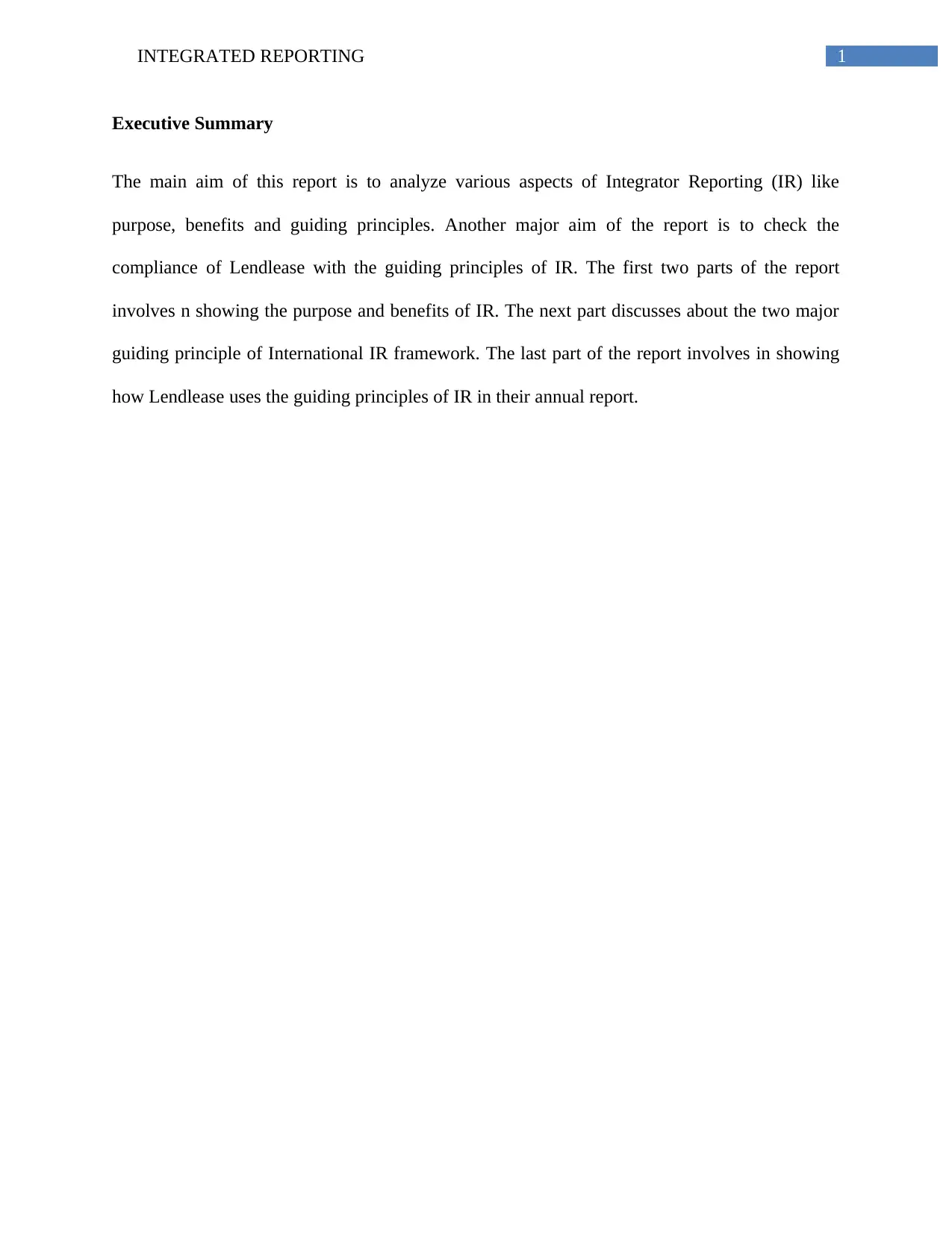
1INTEGRATED REPORTING
Executive Summary
The main aim of this report is to analyze various aspects of Integrator Reporting (IR) like
purpose, benefits and guiding principles. Another major aim of the report is to check the
compliance of Lendlease with the guiding principles of IR. The first two parts of the report
involves n showing the purpose and benefits of IR. The next part discusses about the two major
guiding principle of International IR framework. The last part of the report involves in showing
how Lendlease uses the guiding principles of IR in their annual report.
Executive Summary
The main aim of this report is to analyze various aspects of Integrator Reporting (IR) like
purpose, benefits and guiding principles. Another major aim of the report is to check the
compliance of Lendlease with the guiding principles of IR. The first two parts of the report
involves n showing the purpose and benefits of IR. The next part discusses about the two major
guiding principle of International IR framework. The last part of the report involves in showing
how Lendlease uses the guiding principles of IR in their annual report.
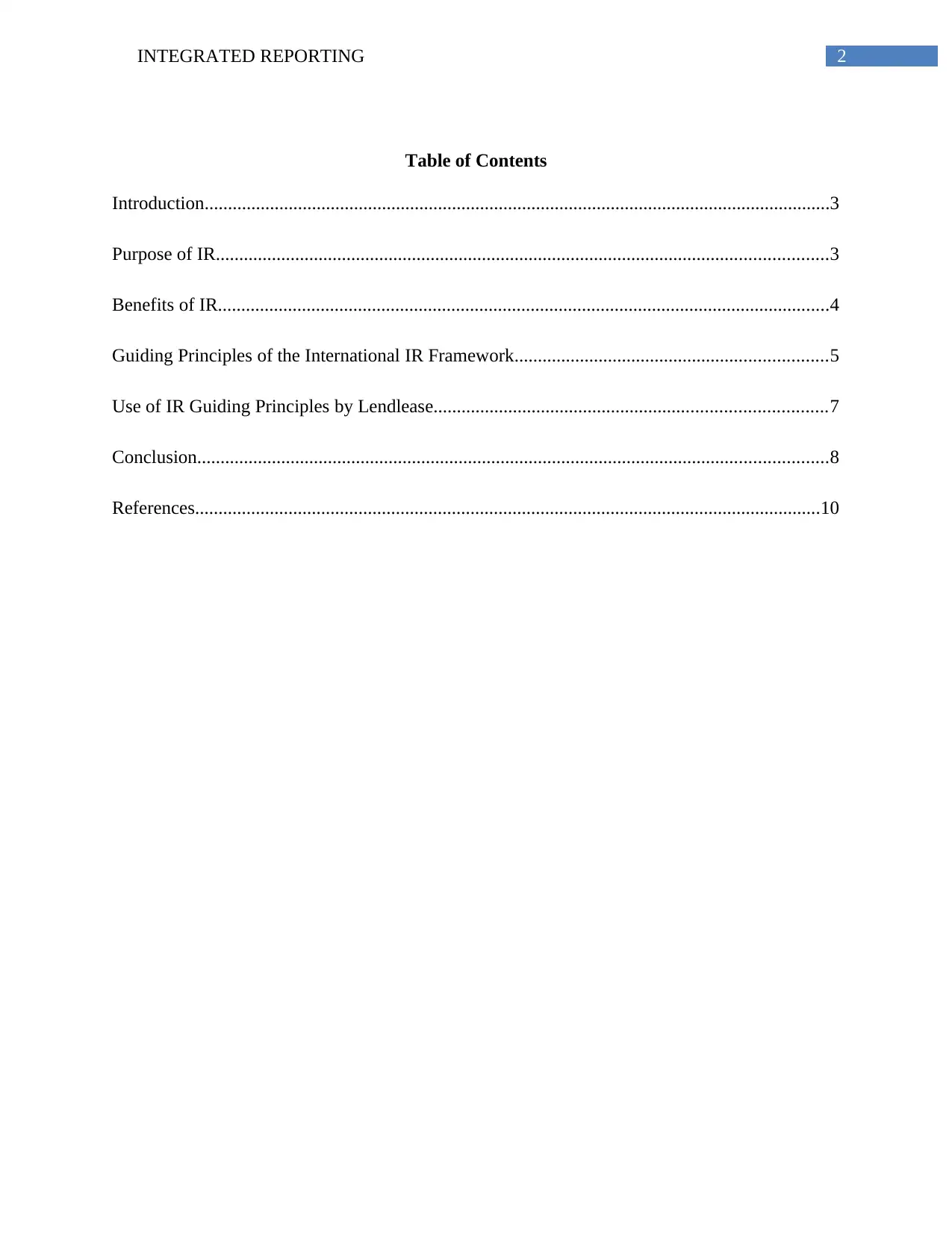
2INTEGRATED REPORTING
Table of Contents
Introduction......................................................................................................................................3
Purpose of IR...................................................................................................................................3
Benefits of IR...................................................................................................................................4
Guiding Principles of the International IR Framework...................................................................5
Use of IR Guiding Principles by Lendlease....................................................................................7
Conclusion.......................................................................................................................................8
References......................................................................................................................................10
Table of Contents
Introduction......................................................................................................................................3
Purpose of IR...................................................................................................................................3
Benefits of IR...................................................................................................................................4
Guiding Principles of the International IR Framework...................................................................5
Use of IR Guiding Principles by Lendlease....................................................................................7
Conclusion.......................................................................................................................................8
References......................................................................................................................................10
⊘ This is a preview!⊘
Do you want full access?
Subscribe today to unlock all pages.

Trusted by 1+ million students worldwide
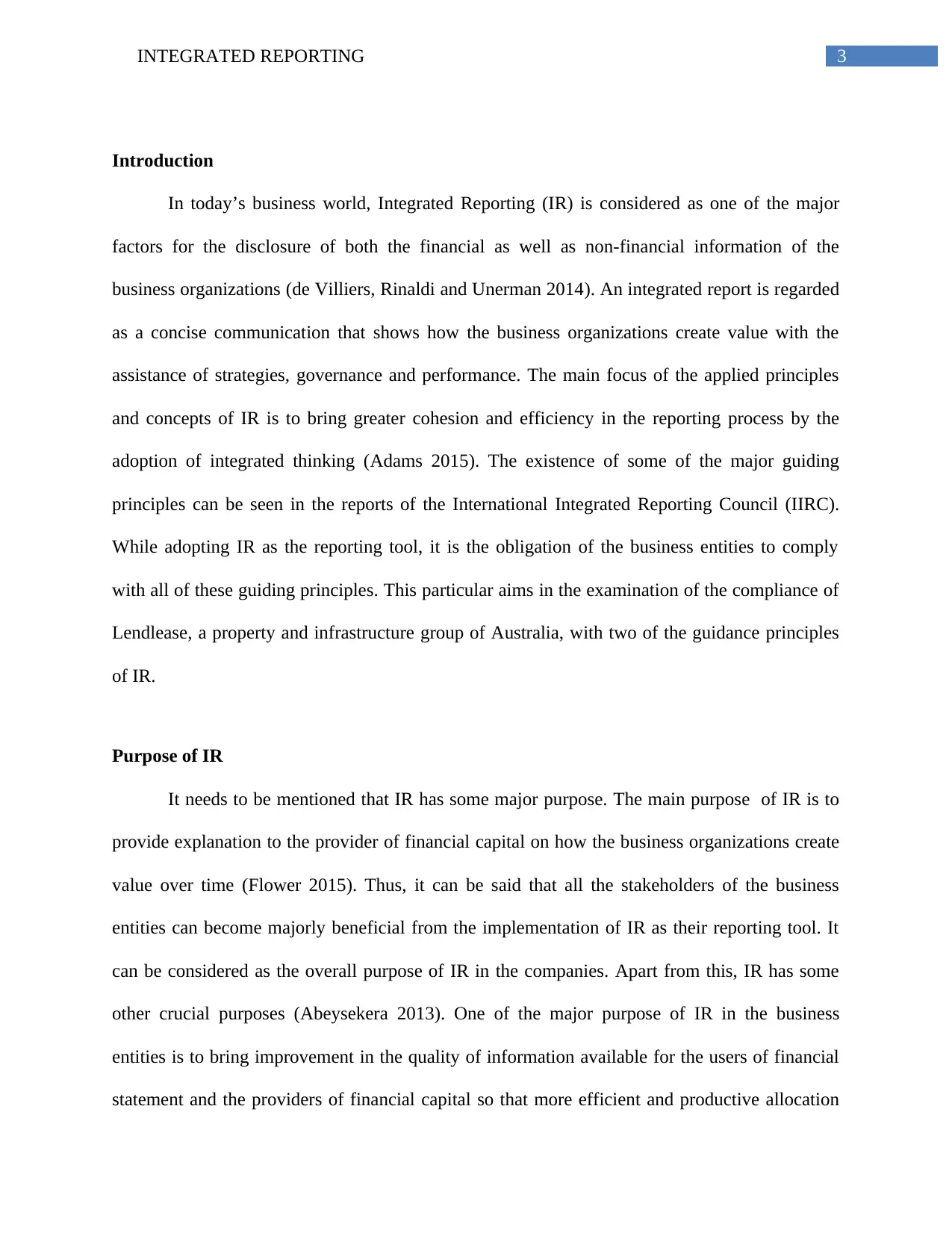
3INTEGRATED REPORTING
Introduction
In today’s business world, Integrated Reporting (IR) is considered as one of the major
factors for the disclosure of both the financial as well as non-financial information of the
business organizations (de Villiers, Rinaldi and Unerman 2014). An integrated report is regarded
as a concise communication that shows how the business organizations create value with the
assistance of strategies, governance and performance. The main focus of the applied principles
and concepts of IR is to bring greater cohesion and efficiency in the reporting process by the
adoption of integrated thinking (Adams 2015). The existence of some of the major guiding
principles can be seen in the reports of the International Integrated Reporting Council (IIRC).
While adopting IR as the reporting tool, it is the obligation of the business entities to comply
with all of these guiding principles. This particular aims in the examination of the compliance of
Lendlease, a property and infrastructure group of Australia, with two of the guidance principles
of IR.
Purpose of IR
It needs to be mentioned that IR has some major purpose. The main purpose of IR is to
provide explanation to the provider of financial capital on how the business organizations create
value over time (Flower 2015). Thus, it can be said that all the stakeholders of the business
entities can become majorly beneficial from the implementation of IR as their reporting tool. It
can be considered as the overall purpose of IR in the companies. Apart from this, IR has some
other crucial purposes (Abeysekera 2013). One of the major purpose of IR in the business
entities is to bring improvement in the quality of information available for the users of financial
statement and the providers of financial capital so that more efficient and productive allocation
Introduction
In today’s business world, Integrated Reporting (IR) is considered as one of the major
factors for the disclosure of both the financial as well as non-financial information of the
business organizations (de Villiers, Rinaldi and Unerman 2014). An integrated report is regarded
as a concise communication that shows how the business organizations create value with the
assistance of strategies, governance and performance. The main focus of the applied principles
and concepts of IR is to bring greater cohesion and efficiency in the reporting process by the
adoption of integrated thinking (Adams 2015). The existence of some of the major guiding
principles can be seen in the reports of the International Integrated Reporting Council (IIRC).
While adopting IR as the reporting tool, it is the obligation of the business entities to comply
with all of these guiding principles. This particular aims in the examination of the compliance of
Lendlease, a property and infrastructure group of Australia, with two of the guidance principles
of IR.
Purpose of IR
It needs to be mentioned that IR has some major purpose. The main purpose of IR is to
provide explanation to the provider of financial capital on how the business organizations create
value over time (Flower 2015). Thus, it can be said that all the stakeholders of the business
entities can become majorly beneficial from the implementation of IR as their reporting tool. It
can be considered as the overall purpose of IR in the companies. Apart from this, IR has some
other crucial purposes (Abeysekera 2013). One of the major purpose of IR in the business
entities is to bring improvement in the quality of information available for the users of financial
statement and the providers of financial capital so that more efficient and productive allocation
Paraphrase This Document
Need a fresh take? Get an instant paraphrase of this document with our AI Paraphraser
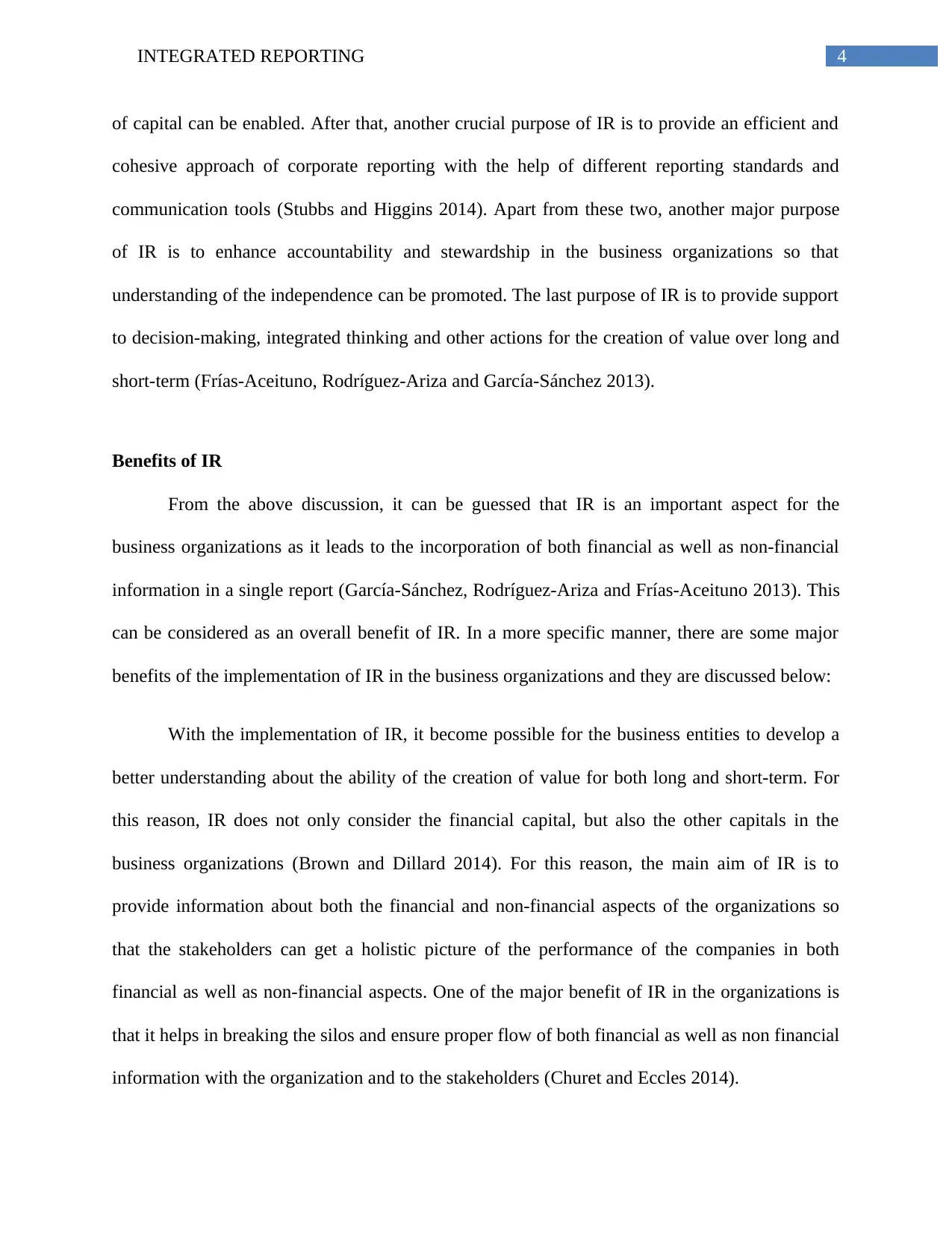
4INTEGRATED REPORTING
of capital can be enabled. After that, another crucial purpose of IR is to provide an efficient and
cohesive approach of corporate reporting with the help of different reporting standards and
communication tools (Stubbs and Higgins 2014). Apart from these two, another major purpose
of IR is to enhance accountability and stewardship in the business organizations so that
understanding of the independence can be promoted. The last purpose of IR is to provide support
to decision-making, integrated thinking and other actions for the creation of value over long and
short-term (Frías-Aceituno, Rodríguez-Ariza and García-Sánchez 2013).
Benefits of IR
From the above discussion, it can be guessed that IR is an important aspect for the
business organizations as it leads to the incorporation of both financial as well as non-financial
information in a single report (García-Sánchez, Rodríguez-Ariza and Frías-Aceituno 2013). This
can be considered as an overall benefit of IR. In a more specific manner, there are some major
benefits of the implementation of IR in the business organizations and they are discussed below:
With the implementation of IR, it become possible for the business entities to develop a
better understanding about the ability of the creation of value for both long and short-term. For
this reason, IR does not only consider the financial capital, but also the other capitals in the
business organizations (Brown and Dillard 2014). For this reason, the main aim of IR is to
provide information about both the financial and non-financial aspects of the organizations so
that the stakeholders can get a holistic picture of the performance of the companies in both
financial as well as non-financial aspects. One of the major benefit of IR in the organizations is
that it helps in breaking the silos and ensure proper flow of both financial as well as non financial
information with the organization and to the stakeholders (Churet and Eccles 2014).
of capital can be enabled. After that, another crucial purpose of IR is to provide an efficient and
cohesive approach of corporate reporting with the help of different reporting standards and
communication tools (Stubbs and Higgins 2014). Apart from these two, another major purpose
of IR is to enhance accountability and stewardship in the business organizations so that
understanding of the independence can be promoted. The last purpose of IR is to provide support
to decision-making, integrated thinking and other actions for the creation of value over long and
short-term (Frías-Aceituno, Rodríguez-Ariza and García-Sánchez 2013).
Benefits of IR
From the above discussion, it can be guessed that IR is an important aspect for the
business organizations as it leads to the incorporation of both financial as well as non-financial
information in a single report (García-Sánchez, Rodríguez-Ariza and Frías-Aceituno 2013). This
can be considered as an overall benefit of IR. In a more specific manner, there are some major
benefits of the implementation of IR in the business organizations and they are discussed below:
With the implementation of IR, it become possible for the business entities to develop a
better understanding about the ability of the creation of value for both long and short-term. For
this reason, IR does not only consider the financial capital, but also the other capitals in the
business organizations (Brown and Dillard 2014). For this reason, the main aim of IR is to
provide information about both the financial and non-financial aspects of the organizations so
that the stakeholders can get a holistic picture of the performance of the companies in both
financial as well as non-financial aspects. One of the major benefit of IR in the organizations is
that it helps in breaking the silos and ensure proper flow of both financial as well as non financial
information with the organization and to the stakeholders (Churet and Eccles 2014).
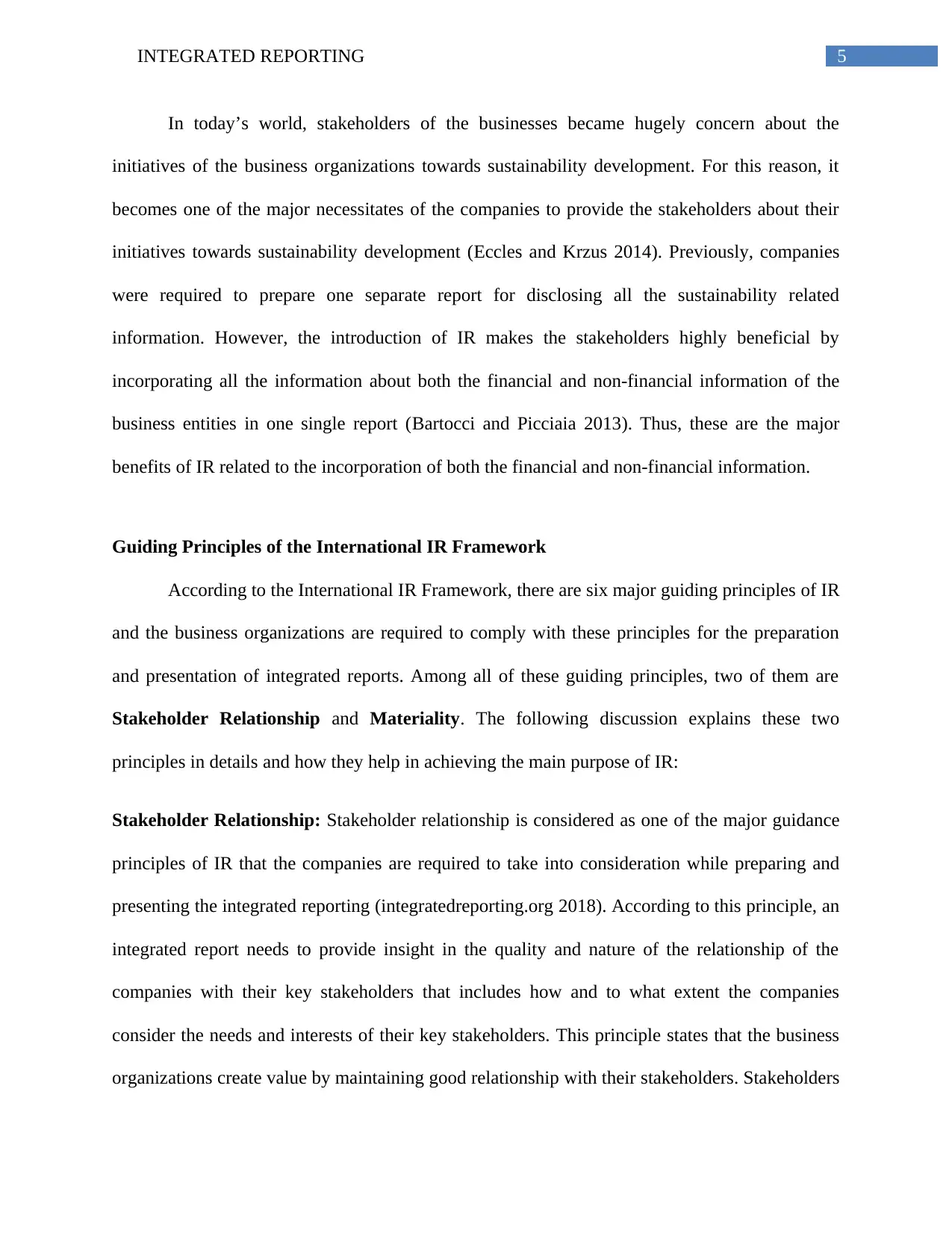
5INTEGRATED REPORTING
In today’s world, stakeholders of the businesses became hugely concern about the
initiatives of the business organizations towards sustainability development. For this reason, it
becomes one of the major necessitates of the companies to provide the stakeholders about their
initiatives towards sustainability development (Eccles and Krzus 2014). Previously, companies
were required to prepare one separate report for disclosing all the sustainability related
information. However, the introduction of IR makes the stakeholders highly beneficial by
incorporating all the information about both the financial and non-financial information of the
business entities in one single report (Bartocci and Picciaia 2013). Thus, these are the major
benefits of IR related to the incorporation of both the financial and non-financial information.
Guiding Principles of the International IR Framework
According to the International IR Framework, there are six major guiding principles of IR
and the business organizations are required to comply with these principles for the preparation
and presentation of integrated reports. Among all of these guiding principles, two of them are
Stakeholder Relationship and Materiality. The following discussion explains these two
principles in details and how they help in achieving the main purpose of IR:
Stakeholder Relationship: Stakeholder relationship is considered as one of the major guidance
principles of IR that the companies are required to take into consideration while preparing and
presenting the integrated reporting (integratedreporting.org 2018). According to this principle, an
integrated report needs to provide insight in the quality and nature of the relationship of the
companies with their key stakeholders that includes how and to what extent the companies
consider the needs and interests of their key stakeholders. This principle states that the business
organizations create value by maintaining good relationship with their stakeholders. Stakeholders
In today’s world, stakeholders of the businesses became hugely concern about the
initiatives of the business organizations towards sustainability development. For this reason, it
becomes one of the major necessitates of the companies to provide the stakeholders about their
initiatives towards sustainability development (Eccles and Krzus 2014). Previously, companies
were required to prepare one separate report for disclosing all the sustainability related
information. However, the introduction of IR makes the stakeholders highly beneficial by
incorporating all the information about both the financial and non-financial information of the
business entities in one single report (Bartocci and Picciaia 2013). Thus, these are the major
benefits of IR related to the incorporation of both the financial and non-financial information.
Guiding Principles of the International IR Framework
According to the International IR Framework, there are six major guiding principles of IR
and the business organizations are required to comply with these principles for the preparation
and presentation of integrated reports. Among all of these guiding principles, two of them are
Stakeholder Relationship and Materiality. The following discussion explains these two
principles in details and how they help in achieving the main purpose of IR:
Stakeholder Relationship: Stakeholder relationship is considered as one of the major guidance
principles of IR that the companies are required to take into consideration while preparing and
presenting the integrated reporting (integratedreporting.org 2018). According to this principle, an
integrated report needs to provide insight in the quality and nature of the relationship of the
companies with their key stakeholders that includes how and to what extent the companies
consider the needs and interests of their key stakeholders. This principle states that the business
organizations create value by maintaining good relationship with their stakeholders. Stakeholders
⊘ This is a preview!⊘
Do you want full access?
Subscribe today to unlock all pages.

Trusted by 1+ million students worldwide
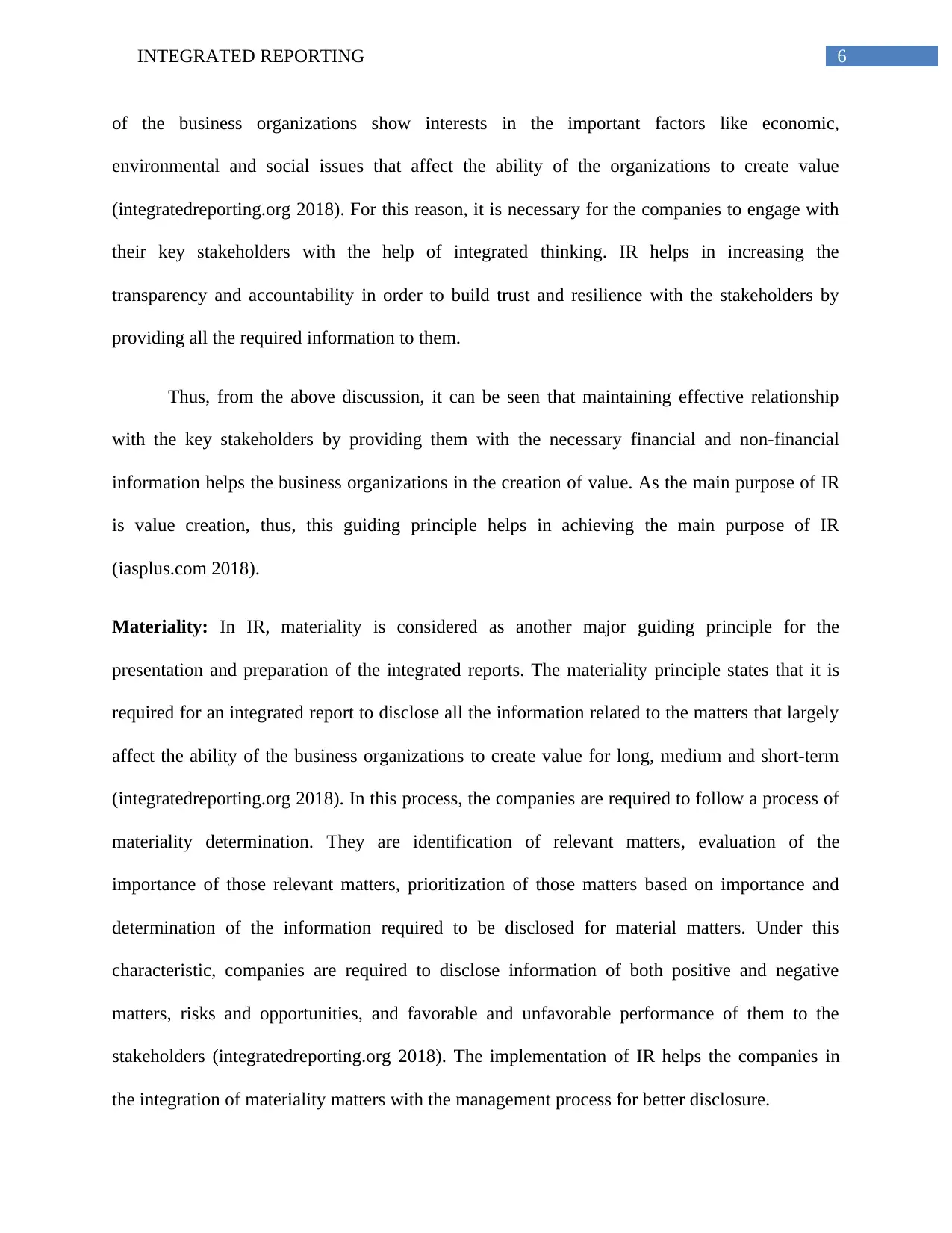
6INTEGRATED REPORTING
of the business organizations show interests in the important factors like economic,
environmental and social issues that affect the ability of the organizations to create value
(integratedreporting.org 2018). For this reason, it is necessary for the companies to engage with
their key stakeholders with the help of integrated thinking. IR helps in increasing the
transparency and accountability in order to build trust and resilience with the stakeholders by
providing all the required information to them.
Thus, from the above discussion, it can be seen that maintaining effective relationship
with the key stakeholders by providing them with the necessary financial and non-financial
information helps the business organizations in the creation of value. As the main purpose of IR
is value creation, thus, this guiding principle helps in achieving the main purpose of IR
(iasplus.com 2018).
Materiality: In IR, materiality is considered as another major guiding principle for the
presentation and preparation of the integrated reports. The materiality principle states that it is
required for an integrated report to disclose all the information related to the matters that largely
affect the ability of the business organizations to create value for long, medium and short-term
(integratedreporting.org 2018). In this process, the companies are required to follow a process of
materiality determination. They are identification of relevant matters, evaluation of the
importance of those relevant matters, prioritization of those matters based on importance and
determination of the information required to be disclosed for material matters. Under this
characteristic, companies are required to disclose information of both positive and negative
matters, risks and opportunities, and favorable and unfavorable performance of them to the
stakeholders (integratedreporting.org 2018). The implementation of IR helps the companies in
the integration of materiality matters with the management process for better disclosure.
of the business organizations show interests in the important factors like economic,
environmental and social issues that affect the ability of the organizations to create value
(integratedreporting.org 2018). For this reason, it is necessary for the companies to engage with
their key stakeholders with the help of integrated thinking. IR helps in increasing the
transparency and accountability in order to build trust and resilience with the stakeholders by
providing all the required information to them.
Thus, from the above discussion, it can be seen that maintaining effective relationship
with the key stakeholders by providing them with the necessary financial and non-financial
information helps the business organizations in the creation of value. As the main purpose of IR
is value creation, thus, this guiding principle helps in achieving the main purpose of IR
(iasplus.com 2018).
Materiality: In IR, materiality is considered as another major guiding principle for the
presentation and preparation of the integrated reports. The materiality principle states that it is
required for an integrated report to disclose all the information related to the matters that largely
affect the ability of the business organizations to create value for long, medium and short-term
(integratedreporting.org 2018). In this process, the companies are required to follow a process of
materiality determination. They are identification of relevant matters, evaluation of the
importance of those relevant matters, prioritization of those matters based on importance and
determination of the information required to be disclosed for material matters. Under this
characteristic, companies are required to disclose information of both positive and negative
matters, risks and opportunities, and favorable and unfavorable performance of them to the
stakeholders (integratedreporting.org 2018). The implementation of IR helps the companies in
the integration of materiality matters with the management process for better disclosure.
Paraphrase This Document
Need a fresh take? Get an instant paraphrase of this document with our AI Paraphraser
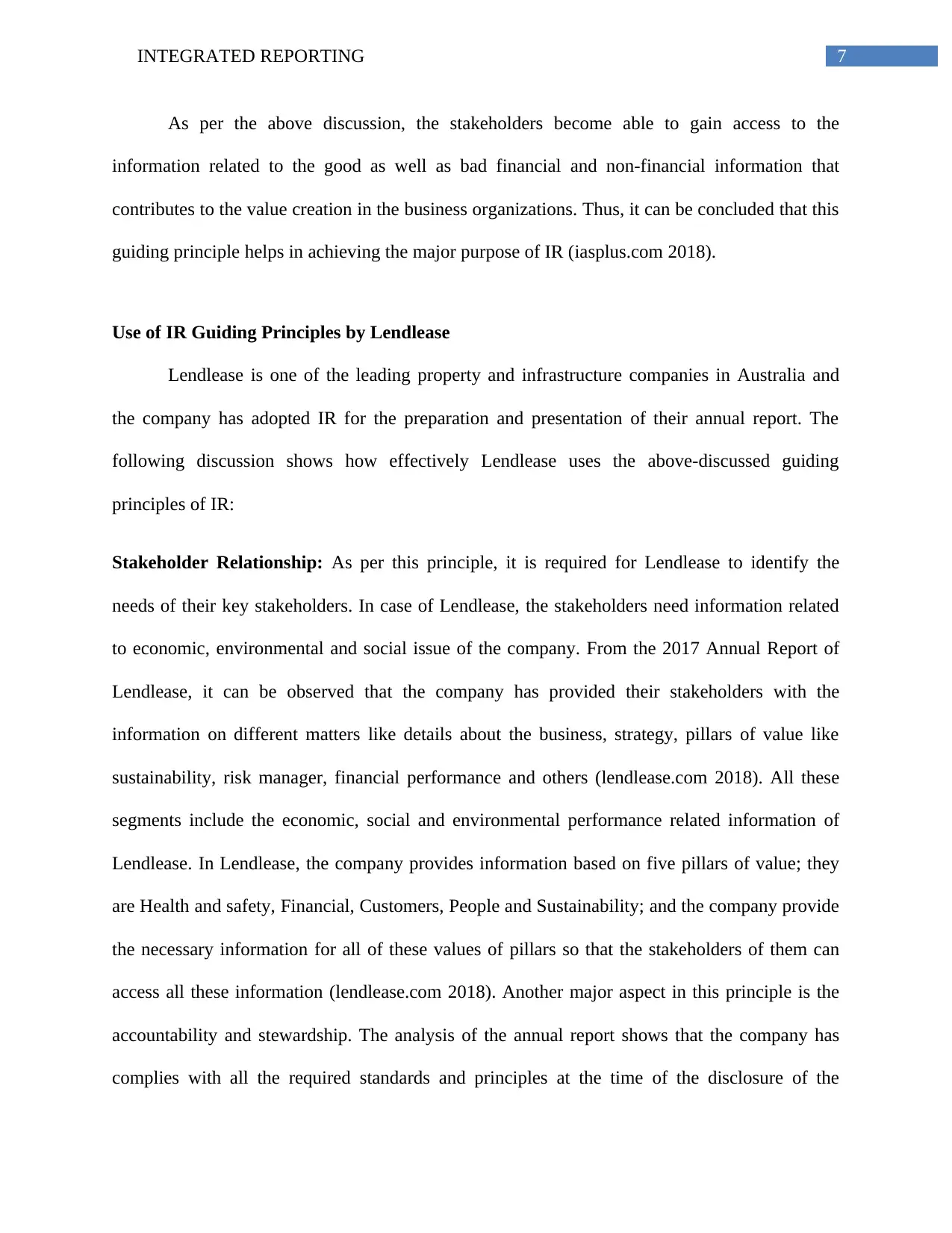
7INTEGRATED REPORTING
As per the above discussion, the stakeholders become able to gain access to the
information related to the good as well as bad financial and non-financial information that
contributes to the value creation in the business organizations. Thus, it can be concluded that this
guiding principle helps in achieving the major purpose of IR (iasplus.com 2018).
Use of IR Guiding Principles by Lendlease
Lendlease is one of the leading property and infrastructure companies in Australia and
the company has adopted IR for the preparation and presentation of their annual report. The
following discussion shows how effectively Lendlease uses the above-discussed guiding
principles of IR:
Stakeholder Relationship: As per this principle, it is required for Lendlease to identify the
needs of their key stakeholders. In case of Lendlease, the stakeholders need information related
to economic, environmental and social issue of the company. From the 2017 Annual Report of
Lendlease, it can be observed that the company has provided their stakeholders with the
information on different matters like details about the business, strategy, pillars of value like
sustainability, risk manager, financial performance and others (lendlease.com 2018). All these
segments include the economic, social and environmental performance related information of
Lendlease. In Lendlease, the company provides information based on five pillars of value; they
are Health and safety, Financial, Customers, People and Sustainability; and the company provide
the necessary information for all of these values of pillars so that the stakeholders of them can
access all these information (lendlease.com 2018). Another major aspect in this principle is the
accountability and stewardship. The analysis of the annual report shows that the company has
complies with all the required standards and principles at the time of the disclosure of the
As per the above discussion, the stakeholders become able to gain access to the
information related to the good as well as bad financial and non-financial information that
contributes to the value creation in the business organizations. Thus, it can be concluded that this
guiding principle helps in achieving the major purpose of IR (iasplus.com 2018).
Use of IR Guiding Principles by Lendlease
Lendlease is one of the leading property and infrastructure companies in Australia and
the company has adopted IR for the preparation and presentation of their annual report. The
following discussion shows how effectively Lendlease uses the above-discussed guiding
principles of IR:
Stakeholder Relationship: As per this principle, it is required for Lendlease to identify the
needs of their key stakeholders. In case of Lendlease, the stakeholders need information related
to economic, environmental and social issue of the company. From the 2017 Annual Report of
Lendlease, it can be observed that the company has provided their stakeholders with the
information on different matters like details about the business, strategy, pillars of value like
sustainability, risk manager, financial performance and others (lendlease.com 2018). All these
segments include the economic, social and environmental performance related information of
Lendlease. In Lendlease, the company provides information based on five pillars of value; they
are Health and safety, Financial, Customers, People and Sustainability; and the company provide
the necessary information for all of these values of pillars so that the stakeholders of them can
access all these information (lendlease.com 2018). Another major aspect in this principle is the
accountability and stewardship. The analysis of the annual report shows that the company has
complies with all the required standards and principles at the time of the disclosure of the
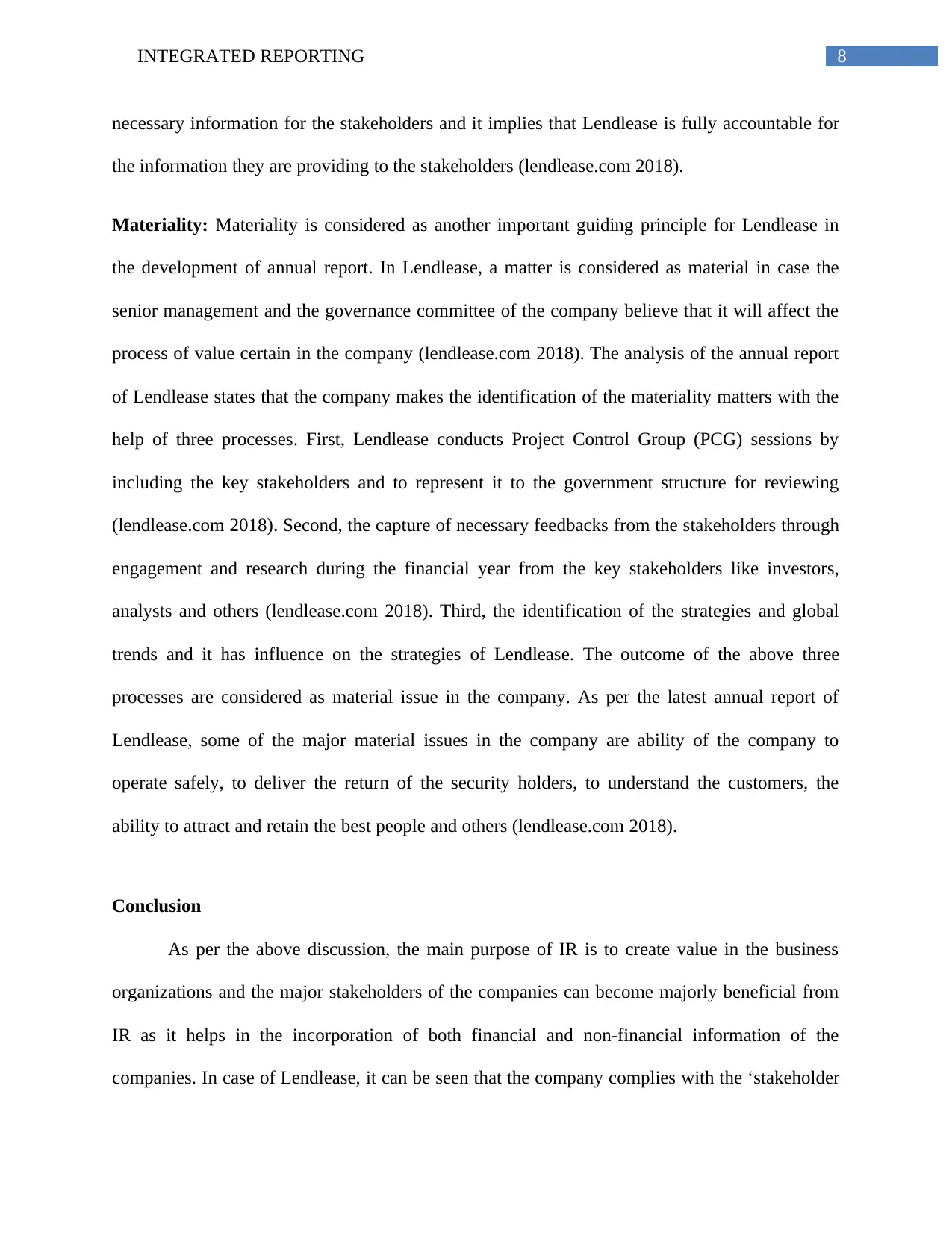
8INTEGRATED REPORTING
necessary information for the stakeholders and it implies that Lendlease is fully accountable for
the information they are providing to the stakeholders (lendlease.com 2018).
Materiality: Materiality is considered as another important guiding principle for Lendlease in
the development of annual report. In Lendlease, a matter is considered as material in case the
senior management and the governance committee of the company believe that it will affect the
process of value certain in the company (lendlease.com 2018). The analysis of the annual report
of Lendlease states that the company makes the identification of the materiality matters with the
help of three processes. First, Lendlease conducts Project Control Group (PCG) sessions by
including the key stakeholders and to represent it to the government structure for reviewing
(lendlease.com 2018). Second, the capture of necessary feedbacks from the stakeholders through
engagement and research during the financial year from the key stakeholders like investors,
analysts and others (lendlease.com 2018). Third, the identification of the strategies and global
trends and it has influence on the strategies of Lendlease. The outcome of the above three
processes are considered as material issue in the company. As per the latest annual report of
Lendlease, some of the major material issues in the company are ability of the company to
operate safely, to deliver the return of the security holders, to understand the customers, the
ability to attract and retain the best people and others (lendlease.com 2018).
Conclusion
As per the above discussion, the main purpose of IR is to create value in the business
organizations and the major stakeholders of the companies can become majorly beneficial from
IR as it helps in the incorporation of both financial and non-financial information of the
companies. In case of Lendlease, it can be seen that the company complies with the ‘stakeholder
necessary information for the stakeholders and it implies that Lendlease is fully accountable for
the information they are providing to the stakeholders (lendlease.com 2018).
Materiality: Materiality is considered as another important guiding principle for Lendlease in
the development of annual report. In Lendlease, a matter is considered as material in case the
senior management and the governance committee of the company believe that it will affect the
process of value certain in the company (lendlease.com 2018). The analysis of the annual report
of Lendlease states that the company makes the identification of the materiality matters with the
help of three processes. First, Lendlease conducts Project Control Group (PCG) sessions by
including the key stakeholders and to represent it to the government structure for reviewing
(lendlease.com 2018). Second, the capture of necessary feedbacks from the stakeholders through
engagement and research during the financial year from the key stakeholders like investors,
analysts and others (lendlease.com 2018). Third, the identification of the strategies and global
trends and it has influence on the strategies of Lendlease. The outcome of the above three
processes are considered as material issue in the company. As per the latest annual report of
Lendlease, some of the major material issues in the company are ability of the company to
operate safely, to deliver the return of the security holders, to understand the customers, the
ability to attract and retain the best people and others (lendlease.com 2018).
Conclusion
As per the above discussion, the main purpose of IR is to create value in the business
organizations and the major stakeholders of the companies can become majorly beneficial from
IR as it helps in the incorporation of both financial and non-financial information of the
companies. In case of Lendlease, it can be seen that the company complies with the ‘stakeholder
⊘ This is a preview!⊘
Do you want full access?
Subscribe today to unlock all pages.

Trusted by 1+ million students worldwide
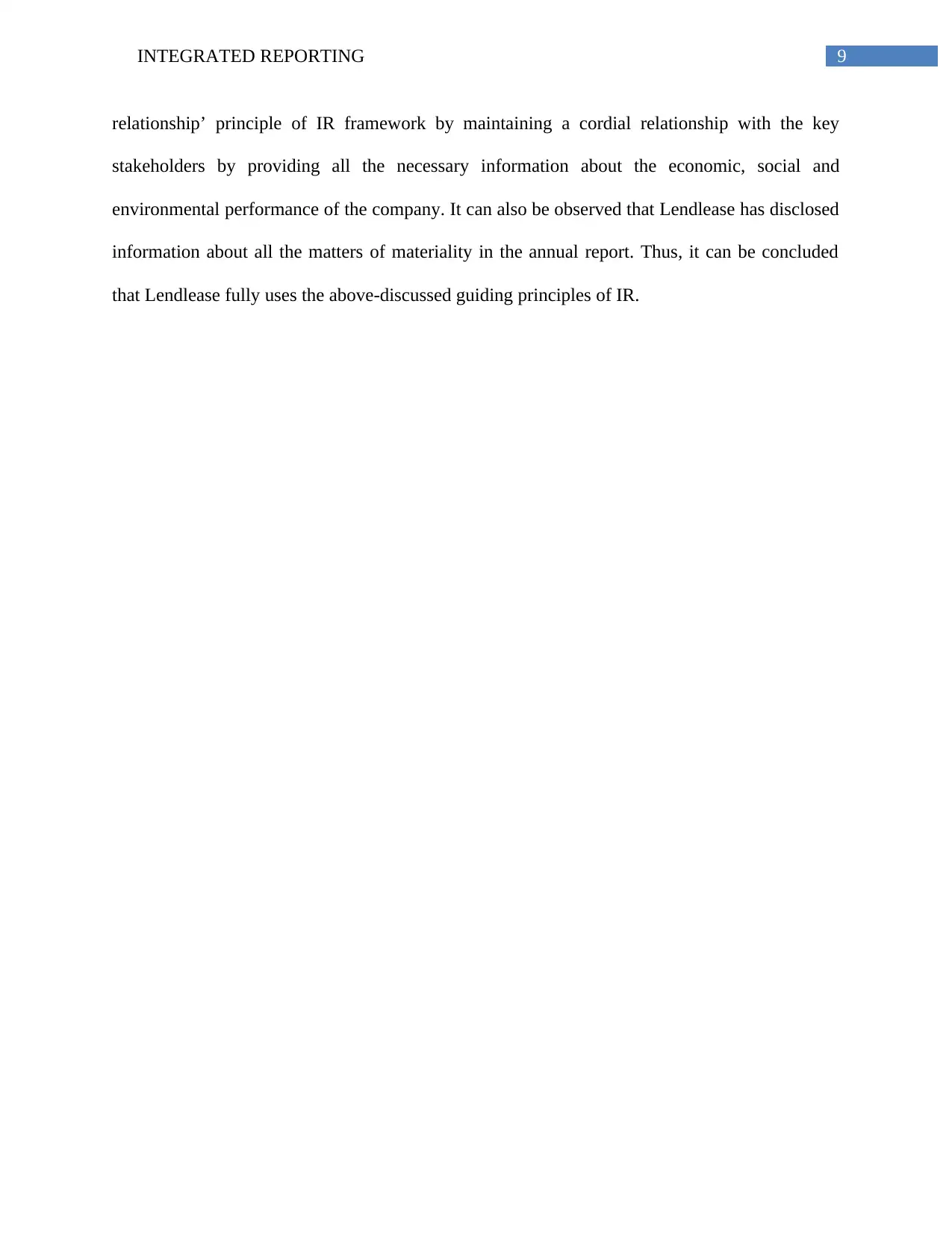
9INTEGRATED REPORTING
relationship’ principle of IR framework by maintaining a cordial relationship with the key
stakeholders by providing all the necessary information about the economic, social and
environmental performance of the company. It can also be observed that Lendlease has disclosed
information about all the matters of materiality in the annual report. Thus, it can be concluded
that Lendlease fully uses the above-discussed guiding principles of IR.
relationship’ principle of IR framework by maintaining a cordial relationship with the key
stakeholders by providing all the necessary information about the economic, social and
environmental performance of the company. It can also be observed that Lendlease has disclosed
information about all the matters of materiality in the annual report. Thus, it can be concluded
that Lendlease fully uses the above-discussed guiding principles of IR.
Paraphrase This Document
Need a fresh take? Get an instant paraphrase of this document with our AI Paraphraser
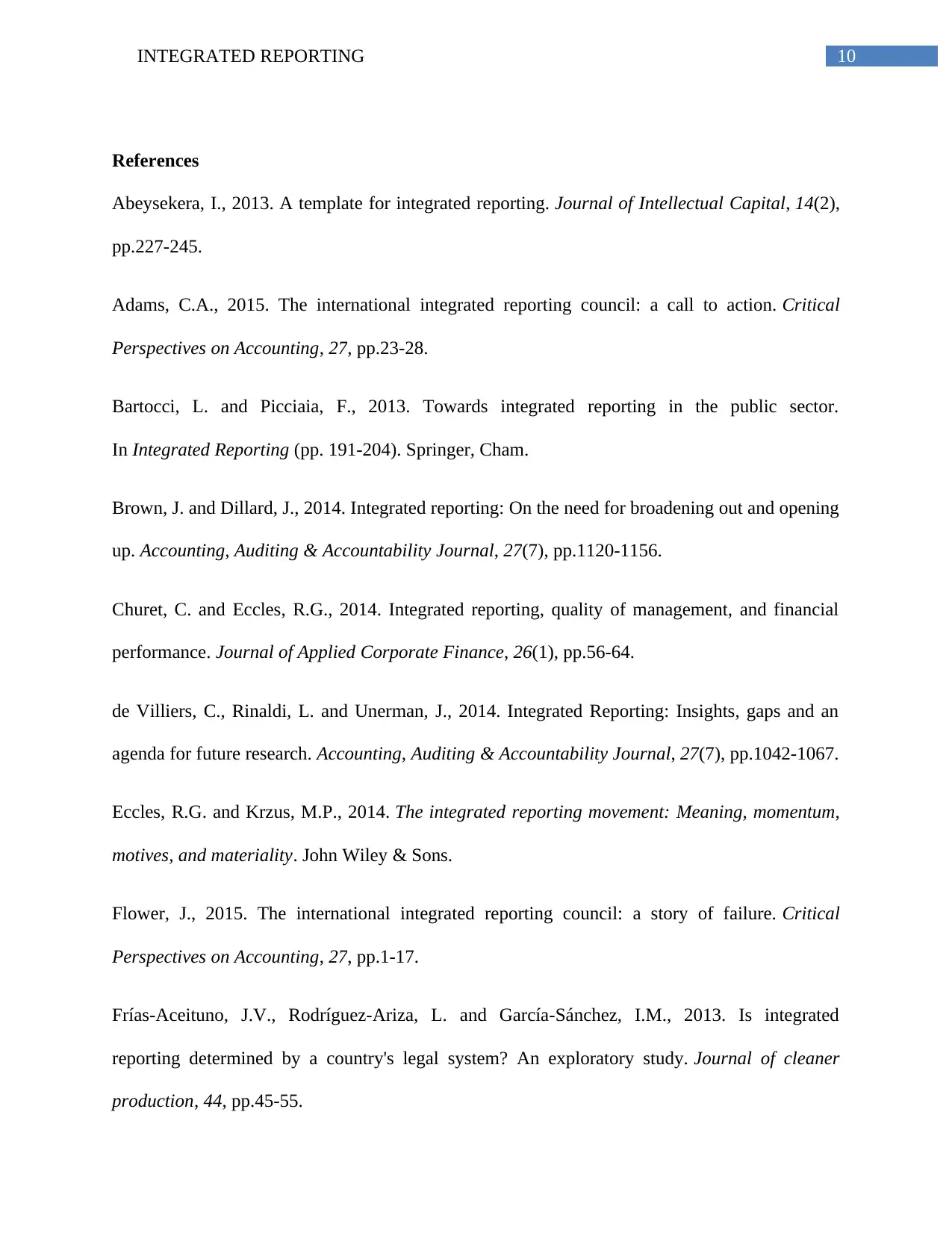
10INTEGRATED REPORTING
References
Abeysekera, I., 2013. A template for integrated reporting. Journal of Intellectual Capital, 14(2),
pp.227-245.
Adams, C.A., 2015. The international integrated reporting council: a call to action. Critical
Perspectives on Accounting, 27, pp.23-28.
Bartocci, L. and Picciaia, F., 2013. Towards integrated reporting in the public sector.
In Integrated Reporting (pp. 191-204). Springer, Cham.
Brown, J. and Dillard, J., 2014. Integrated reporting: On the need for broadening out and opening
up. Accounting, Auditing & Accountability Journal, 27(7), pp.1120-1156.
Churet, C. and Eccles, R.G., 2014. Integrated reporting, quality of management, and financial
performance. Journal of Applied Corporate Finance, 26(1), pp.56-64.
de Villiers, C., Rinaldi, L. and Unerman, J., 2014. Integrated Reporting: Insights, gaps and an
agenda for future research. Accounting, Auditing & Accountability Journal, 27(7), pp.1042-1067.
Eccles, R.G. and Krzus, M.P., 2014. The integrated reporting movement: Meaning, momentum,
motives, and materiality. John Wiley & Sons.
Flower, J., 2015. The international integrated reporting council: a story of failure. Critical
Perspectives on Accounting, 27, pp.1-17.
Frías-Aceituno, J.V., Rodríguez-Ariza, L. and García-Sánchez, I.M., 2013. Is integrated
reporting determined by a country's legal system? An exploratory study. Journal of cleaner
production, 44, pp.45-55.
References
Abeysekera, I., 2013. A template for integrated reporting. Journal of Intellectual Capital, 14(2),
pp.227-245.
Adams, C.A., 2015. The international integrated reporting council: a call to action. Critical
Perspectives on Accounting, 27, pp.23-28.
Bartocci, L. and Picciaia, F., 2013. Towards integrated reporting in the public sector.
In Integrated Reporting (pp. 191-204). Springer, Cham.
Brown, J. and Dillard, J., 2014. Integrated reporting: On the need for broadening out and opening
up. Accounting, Auditing & Accountability Journal, 27(7), pp.1120-1156.
Churet, C. and Eccles, R.G., 2014. Integrated reporting, quality of management, and financial
performance. Journal of Applied Corporate Finance, 26(1), pp.56-64.
de Villiers, C., Rinaldi, L. and Unerman, J., 2014. Integrated Reporting: Insights, gaps and an
agenda for future research. Accounting, Auditing & Accountability Journal, 27(7), pp.1042-1067.
Eccles, R.G. and Krzus, M.P., 2014. The integrated reporting movement: Meaning, momentum,
motives, and materiality. John Wiley & Sons.
Flower, J., 2015. The international integrated reporting council: a story of failure. Critical
Perspectives on Accounting, 27, pp.1-17.
Frías-Aceituno, J.V., Rodríguez-Ariza, L. and García-Sánchez, I.M., 2013. Is integrated
reporting determined by a country's legal system? An exploratory study. Journal of cleaner
production, 44, pp.45-55.
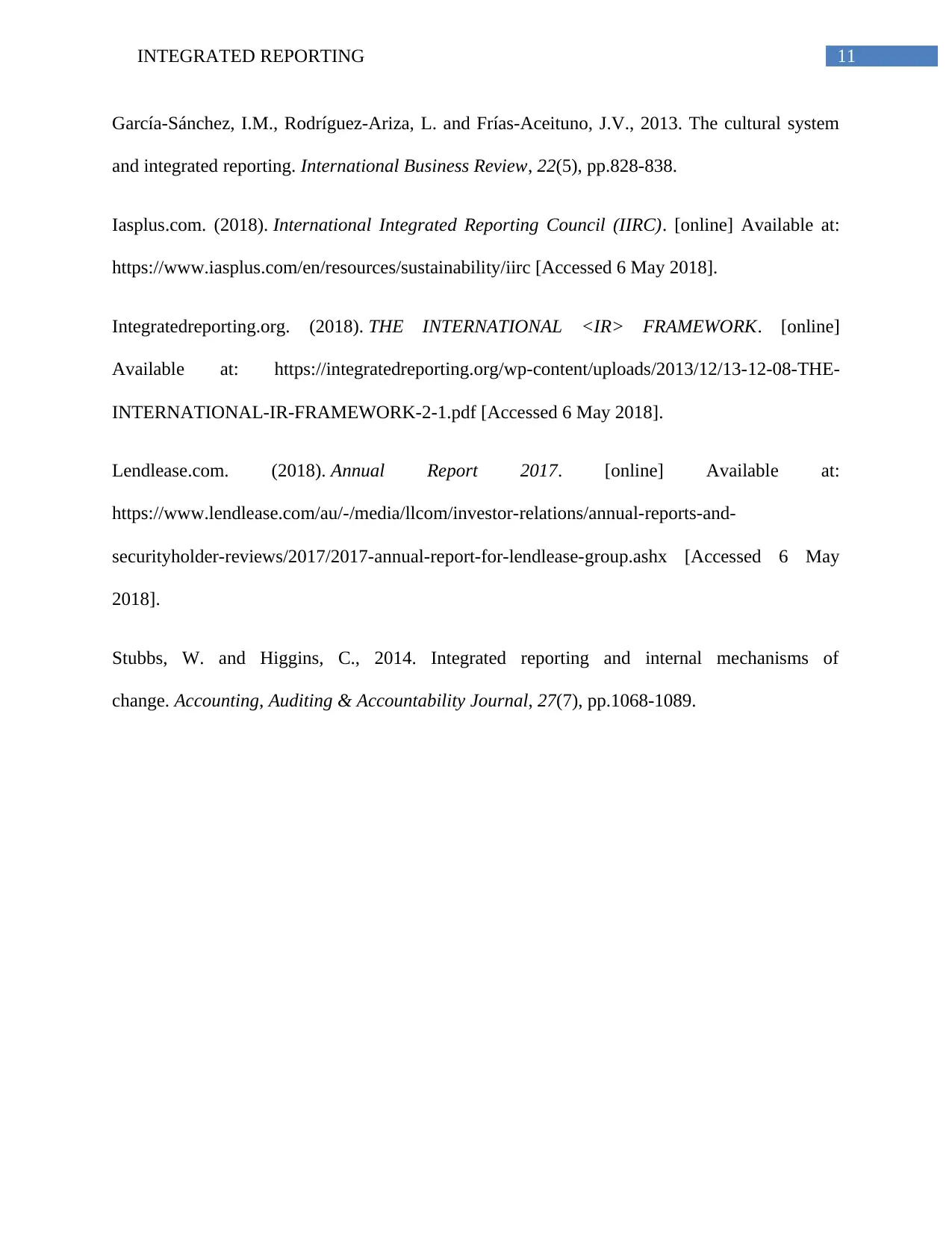
11INTEGRATED REPORTING
García-Sánchez, I.M., Rodríguez-Ariza, L. and Frías-Aceituno, J.V., 2013. The cultural system
and integrated reporting. International Business Review, 22(5), pp.828-838.
Iasplus.com. (2018). International Integrated Reporting Council (IIRC). [online] Available at:
https://www.iasplus.com/en/resources/sustainability/iirc [Accessed 6 May 2018].
Integratedreporting.org. (2018). THE INTERNATIONAL <IR> FRAMEWORK. [online]
Available at: https://integratedreporting.org/wp-content/uploads/2013/12/13-12-08-THE-
INTERNATIONAL-IR-FRAMEWORK-2-1.pdf [Accessed 6 May 2018].
Lendlease.com. (2018). Annual Report 2017. [online] Available at:
https://www.lendlease.com/au/-/media/llcom/investor-relations/annual-reports-and-
securityholder-reviews/2017/2017-annual-report-for-lendlease-group.ashx [Accessed 6 May
2018].
Stubbs, W. and Higgins, C., 2014. Integrated reporting and internal mechanisms of
change. Accounting, Auditing & Accountability Journal, 27(7), pp.1068-1089.
García-Sánchez, I.M., Rodríguez-Ariza, L. and Frías-Aceituno, J.V., 2013. The cultural system
and integrated reporting. International Business Review, 22(5), pp.828-838.
Iasplus.com. (2018). International Integrated Reporting Council (IIRC). [online] Available at:
https://www.iasplus.com/en/resources/sustainability/iirc [Accessed 6 May 2018].
Integratedreporting.org. (2018). THE INTERNATIONAL <IR> FRAMEWORK. [online]
Available at: https://integratedreporting.org/wp-content/uploads/2013/12/13-12-08-THE-
INTERNATIONAL-IR-FRAMEWORK-2-1.pdf [Accessed 6 May 2018].
Lendlease.com. (2018). Annual Report 2017. [online] Available at:
https://www.lendlease.com/au/-/media/llcom/investor-relations/annual-reports-and-
securityholder-reviews/2017/2017-annual-report-for-lendlease-group.ashx [Accessed 6 May
2018].
Stubbs, W. and Higgins, C., 2014. Integrated reporting and internal mechanisms of
change. Accounting, Auditing & Accountability Journal, 27(7), pp.1068-1089.
⊘ This is a preview!⊘
Do you want full access?
Subscribe today to unlock all pages.

Trusted by 1+ million students worldwide
1 out of 12
Related Documents
Your All-in-One AI-Powered Toolkit for Academic Success.
+13062052269
info@desklib.com
Available 24*7 on WhatsApp / Email
![[object Object]](/_next/static/media/star-bottom.7253800d.svg)
Unlock your academic potential
Copyright © 2020–2025 A2Z Services. All Rights Reserved. Developed and managed by ZUCOL.




